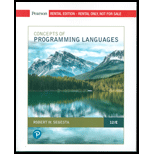
EBK CONCEPTS OF PROGRAMMING LANGUAGES
12th Edition
ISBN: 9780135102251
Author: Sebesta
Publisher: VST
expand_more
expand_more
format_list_bulleted
Expert Solution & Answer
Chapter 1, Problem 13PS
Explanation of Solution
Features in first high-level
The first high level language which we learned was C++. A high level language is more close to humans and is not designed specifically for the machine. High level languages provide important features such as abstraction, exception handling and others.
- A programming language can be implemented either using a compiler, a pure interpreter or a hybrid implementation of both interpreter and compiler.
- C++ is more of a compiled language and that is one of the reasons of its efficiency. But some of the programming environments also provide interpreted form of the code for easier debugging.
Compiled languages are usually faster during execution.
- Firstly, the program is passed to lexical analyzer which gathers different lexemes like keywords, punctuations and others of the code.
- This information is then passed to syntactic analyzer which makes parse trees out of this information...
Expert Solution & Answer
Want to see the full answer?
Check out a sample textbook solution
Students have asked these similar questions
4. |z + 5 - 5i| = 7
14.
dz,
C: |z❘
C: |z❘ = 0.6
ze² - 2iz
H
14.
dz,
C: |z❘
C: |z❘ = 0.6
ze² - 2iz
H
Chapter 1 Solutions
EBK CONCEPTS OF PROGRAMMING LANGUAGES
Ch. 1 - Why is it useful for a programmer to have some...Ch. 1 - Prob. 2RQCh. 1 - Prob. 3RQCh. 1 - Prob. 4RQCh. 1 - Prob. 5RQCh. 1 - In what language is most of UNIX written?Ch. 1 - What is the disadvantage of having too many...Ch. 1 - How can user-defined operator overloading harm the...Ch. 1 - Prob. 9RQCh. 1 - Prob. 10RQ
Ch. 1 - Describe some design trade-offs between efficiency...Ch. 1 - Prob. 12RQCh. 1 - Prob. 13RQCh. 1 - Prob. 14RQCh. 1 - Prob. 15RQCh. 1 - Prob. 16RQCh. 1 - Prob. 17RQCh. 1 - Prob. 18RQCh. 1 - Prob. 19RQCh. 1 - Prob. 20RQCh. 1 - Prob. 21RQCh. 1 - Prob. 22RQCh. 1 - Prob. 23RQCh. 1 - Prob. 24RQCh. 1 - Prob. 25RQCh. 1 - What role does the symbol table play in a...Ch. 1 - Prob. 27RQCh. 1 - Prob. 28RQCh. 1 - What are the advantages in implementing a language...Ch. 1 - Prob. 1PSCh. 1 - What are some features of specific programming...Ch. 1 - Prob. 3PSCh. 1 - Prob. 4PSCh. 1 - Prob. 5PSCh. 1 - What common programming language statement, in...Ch. 1 - Java uses a right brace to mark the end of all...Ch. 1 - Prob. 8PSCh. 1 - Explain the different aspects of the cost of a...Ch. 1 - Prob. 10PSCh. 1 - Describe some design trade-offs between efficiency...Ch. 1 - Prob. 12PSCh. 1 - Prob. 13PSCh. 1 - Prob. 14PSCh. 1 - How do type declaration statements for simple...Ch. 1 - Write an evaluation of some programming language...Ch. 1 - Prob. 17PSCh. 1 - Many contemporary languages allow two kinds of...
Knowledge Booster
Similar questions
arrow_back_ios
SEE MORE QUESTIONS
arrow_forward_ios
Recommended textbooks for you
 Systems ArchitectureComputer ScienceISBN:9781305080195Author:Stephen D. BurdPublisher:Cengage Learning
Systems ArchitectureComputer ScienceISBN:9781305080195Author:Stephen D. BurdPublisher:Cengage Learning C++ for Engineers and ScientistsComputer ScienceISBN:9781133187844Author:Bronson, Gary J.Publisher:Course Technology Ptr
C++ for Engineers and ScientistsComputer ScienceISBN:9781133187844Author:Bronson, Gary J.Publisher:Course Technology Ptr Fundamentals of Information SystemsComputer ScienceISBN:9781305082168Author:Ralph Stair, George ReynoldsPublisher:Cengage Learning
Fundamentals of Information SystemsComputer ScienceISBN:9781305082168Author:Ralph Stair, George ReynoldsPublisher:Cengage Learning Microsoft Visual C#Computer ScienceISBN:9781337102100Author:Joyce, Farrell.Publisher:Cengage Learning,
Microsoft Visual C#Computer ScienceISBN:9781337102100Author:Joyce, Farrell.Publisher:Cengage Learning, Principles of Information Systems (MindTap Course...Computer ScienceISBN:9781285867168Author:Ralph Stair, George ReynoldsPublisher:Cengage Learning
Principles of Information Systems (MindTap Course...Computer ScienceISBN:9781285867168Author:Ralph Stair, George ReynoldsPublisher:Cengage Learning Enhanced Discovering Computers 2017 (Shelly Cashm...Computer ScienceISBN:9781305657458Author:Misty E. Vermaat, Susan L. Sebok, Steven M. Freund, Mark Frydenberg, Jennifer T. CampbellPublisher:Cengage Learning
Enhanced Discovering Computers 2017 (Shelly Cashm...Computer ScienceISBN:9781305657458Author:Misty E. Vermaat, Susan L. Sebok, Steven M. Freund, Mark Frydenberg, Jennifer T. CampbellPublisher:Cengage Learning

Systems Architecture
Computer Science
ISBN:9781305080195
Author:Stephen D. Burd
Publisher:Cengage Learning

C++ for Engineers and Scientists
Computer Science
ISBN:9781133187844
Author:Bronson, Gary J.
Publisher:Course Technology Ptr

Fundamentals of Information Systems
Computer Science
ISBN:9781305082168
Author:Ralph Stair, George Reynolds
Publisher:Cengage Learning

Microsoft Visual C#
Computer Science
ISBN:9781337102100
Author:Joyce, Farrell.
Publisher:Cengage Learning,

Principles of Information Systems (MindTap Course...
Computer Science
ISBN:9781285867168
Author:Ralph Stair, George Reynolds
Publisher:Cengage Learning

Enhanced Discovering Computers 2017 (Shelly Cashm...
Computer Science
ISBN:9781305657458
Author:Misty E. Vermaat, Susan L. Sebok, Steven M. Freund, Mark Frydenberg, Jennifer T. Campbell
Publisher:Cengage Learning